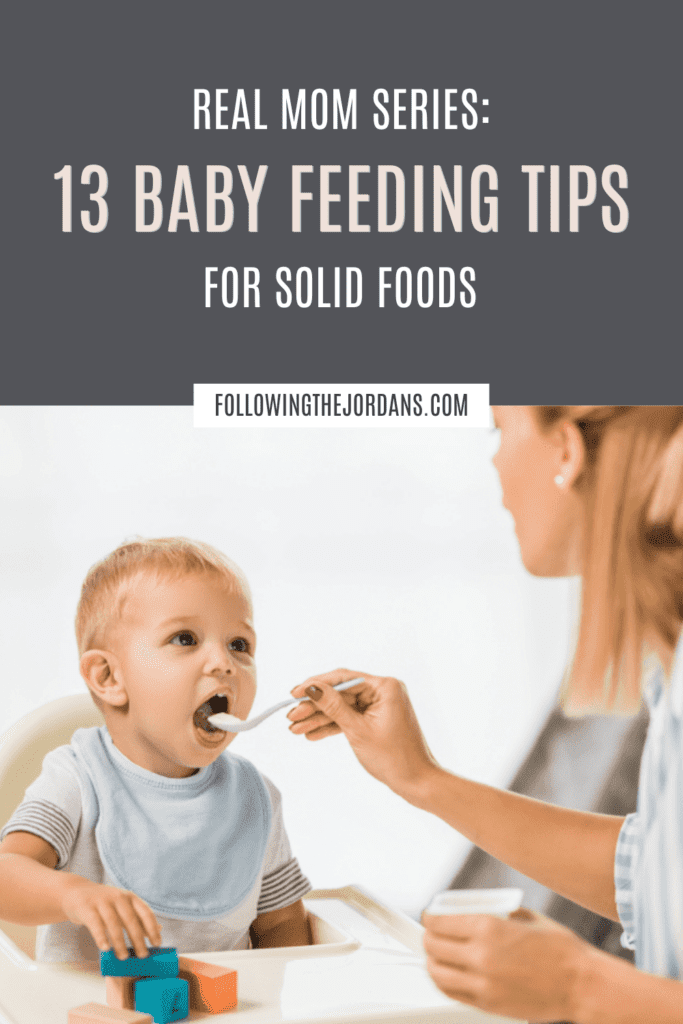Real Mom Series: 13 Baby Feeding Tips for Solid Foods
Eventually, it’s time to introduce baby food to your infant; it’s an exciting and big milestone for your child. As you embark on this new journey together of food discovery, you’ll need to know some of these feeding tips for solid foods. It’s different than giving bottles or breast feeding!
I remember the first time I gave all of my babies their first tastes of solid foods; their reactions were always gems. Some were horrified, and others thought I gave them a spoonful of ice cream based on how their eyes lit up. It’s such a fun moment to enjoy as parents, but after that, you have to know the ins and outs.
You start by remembering it’s just for fun – but what does that mean? What is the rule of 3? And, do eggs have to stay off their plate until they’re a year old?
I know I met with a lot of confusing answers. Everyone seemed to have a different answer, so I had to do a lot of research to figure out what was best for my kids. I put all those tips I learned for feeding your baby solid foods here!
Pin this blog for later! ↓

Related: Breastfeeding: What To Expect The First 2 Weeks
13 Tips for Feeding Your Baby Solid Foods

1. Remember: Breast or Formula is Best for One Year
Before you start feeding your baby solid foods, remember that these foods are just for fun. If your baby isn’t ready or doesn’t eat as much as you think they should that day, it’s okay. Breastmilk and formula are the primary ways that your baby gets all of their nutrients during the first year of life.
However, it is important to introduce solid foods and work towards eating a fully solid food diet like a toddler eats. This takes time though and will happen over time.
2. Wait Until Your Baby is 6 Months Old
The American Academy of Pediatrics recommends waiting until your baby is four to six months old. Babies should be able to hold up their heads without any aide and should be able to sit in a high chair with ease. Your baby should have the core strength to sit in their seat.
3. Skip the Cereals
Years ago, the recommendations was to start with cereals and grains with that idea that they were easier for a baby’s stomach to handle. Evidence suggests otherwise.
Cereals provide little nutritional value to your infant besides the iron they have through fortification. Some babies don’t handle grains well, leading to constipation. Instead, most doctor suggest that you start by giving your baby a single fruit or vegetable puree as their first foods. Save the cereal for breakfast mixed with some apples or peaches!
4. Start with One Fruit or Vegetable at a Time
One important feeding tip to know is that you should take your time and feed one fruit or vegetable at the time; don’t jump to combinations too fast.
For example, perhaps you start with carrots and move to apples. Start by feeding your baby carrots – and only carrots – for three to four days. Watch for any type of reaction that my indicate your baby’s body doesn’t tolerate this food well. Then, if all is well, move onto the next food.
You shouldn’t offer combined foods until you have introduce each separately because it allows you to know if a food bothers your baby. If you give two new foods at one time, you won’t be sure which one caused the diaper rash or belly ache!
5. Start Runny & Get Thicker Gradually

When you start feeding your baby solid foods, they aren’t used to these foods, and if you give them foods that are too thick, they’ll gag or won’t know how to handle it in their mouths. In the beginning, you need to thin it down with water, breast milk, or formula.
As your baby becomes more accustomed to eating solid foods, you’ll be able to make the foods thicker, eventually leaving soft chunks for your baby to practice chewing.
6. Don’t Forget the Bibs!
One thing you don’t want to forgo is bibs. Introducing solid foods to your baby brings about a whole new type of mess to handle, and the stains you’ll have to battle otherwise will be insane.
My favorite bibs are the silicone bib with pockets. Whenever your baby starts eating finger foods, they drop a TON, and the pocket collects them rather than the high chair or their laps. Silicone wipes clean easily and won’t stain or leak through like cloth bibs.
7. Start with Solid Foods Once Per Day
Your baby doesn’t have to eat three meals a day as soon as you bust out the baby foods. That’s your goal when your baby is a year old, but for right now, your goal is to start with one meal a day, and you don’t want to replace breastfeeding or formula bottles.
Typically, you’ll offer the breast or bottle first before setting up the solid foods. Their belly is full, so they are exploring and happy. This ensures they aren’t missing any of their nutrients or vitamins needed by filling up with baby foods.
8. Feed When Your Baby is Happy
Have you ever realized how much easier it is to get your baby to do anything when they’re happy? The same goes for eating baby food! If your baby isn’t in the best of moods, it may not be the best time to convince him to eat some food. Chances are you’ll end up with a grumpy, yelling child.
9. Expose Your Babies to New Foods Regularly

Previous advice told parents that they needed to wait to introduce high allergens food to their diet, such as eggs, dairy, fish, or peanuts. This advice is outdated; you can give eggs as first foods if you want. Dairy is great at six months since infants love yogurt.
The exception to this advice would be if you have a family history of food allergies. For example, if you or your husband is allergic to fish, it is wise to hold off shortly and consider asking your doctor to allow you to introduce the foods in office and monitor for any reactions. This is particularly a safe route if you are worried about a serious allergic reaction.
As you continue to add foods to your baby’s diet, don’t be afraid to expose him to new foods regularly. You want your baby to try new foods and become a lover of all sorts of food.
10. Make Your Own Solid Foods
One of my favorite feeding tips for families is to make your own baby food for your infant. Not only does it save you money, but you can give your baby the best quality of food and create unique blends. I always felt like the foods I made for my babies tasted better than the pouches or jars I bought in the store. That may be due to the freshness of the veggies and fruits.
All you need is a good blender, silicone ice cube trays, and some Ziploc bags to store the baby food in the freezer for bulk cooking. It’s easier than you imagine, and you can save money by shopping the sales and making big batches for cheap.
For example, if you find a great deal on apples, you can buy several pounds, cook or steam the apples, and blend them into a delicious applesauce. The flavor will be much better than the store-bought apple baby food, and you saved dollars – score!
11. Include Spices!
It’s safe to give your baby spices in their foods once you know that the foods themselves won’t cause a reaction. I always included a bit of cinnamon into the applesauce I pureed; it always tastes better, right?
Don’t be afraid to toss in small sprinkles of seasoning to whatever you create for your baby to see if they like the different flavor profiles. It creates more interesting meals and exposes your infant to more flavors early, which tend to help create adventurous eaters.
12. Puree Your Meals – It’s Ok!
When your baby is older, it’s safe to puree meals that you have with your family to give your baby. Generally, this is once your baby is nine months or older and has tried all of the “basic” baby foods.
One of my son’s favorite was when I made chicken pot pie and pureed the filling for him. He would eat so much of it; it was a favorite. You might notice when you go to the store that the stage 3 and 4 baby foods are meals, some of them chunky. You’ll find meals like spaghetti or chicken and rice. These are more than likely meals you make for your family already, so puree it yourself for your baby.
I bet your version is better than what the companies make anyway.
13. Keep It Positive
Overall, I want to encourage you to keep and make this experience a positive one for you and your baby. Some days, your baby may feel a bit poorly due to teething, and he would rather spend all day at the breast than touch a bite of baby food.
That’s okay – I promise!
Follow your baby’s lead, gradually trying more foods over time but pulling back when you have a rough week. It’s okay; progress is not always perfectly linear. Enjoy the new food journey with your child.
I hope these feeding tips for solid foods from a real mom help you have the best experiences as you introduce baby food to your infant. Enjoy the journey together!






